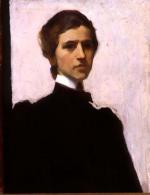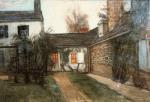![header=[Marker Text] body=[Artist famed for her murals in Pennsylvania's State Capitol, reflecting Penn's ideals of justice and peace. Also noted for her work in stained glass; book and magazine illustrations. One of three women artists who moved in 1906 to "Cogslea," she lived and worked here until 1961.] sign](http://explorepahistory.com/kora/files/1/10/1-A-19E-139-ExplorePAHistory-a0a9n9-a_450.gif)
Mouse over for marker text
Name:
Violet Oakley
Region:
Philadelphia and its Countryside/Lehigh Valley
County:
Philadelphia
Marker Location:
St. Georges Rd. off McCallum St., Philadelphia
Dedication Date:
October 20, 1998
Behind the Marker
Visitors to the Pennsylvania State Capitol in Harrisburg might not be surprised by the murals in the House of Representatives chamber. There, William Penn negotiates with the Indians, a mean reads the Declaration of Independence, and in the center "The Apotheosis of Pennsylvania" depicts the great white men of the Commonwealth's history. In the Senate Chamber, however, the central mural shows the figure of a woman representing "International Unity and Understanding." She presides over the end of all warfare that many Americans briefly believed would be the product of World War I. Kings give up their crowns, a Red Cross worker joins a soldier in washing the blood off his hands, a black woman cleanses her baby in water, a slave is freed, and laborers beat swords into ploughshares. Women, one of them the pacifist Jane Addams and most of them women of color, join male workers in framing a painting in which the rich and powerful are absent.
The Senate murals were executed by Edwin Austin Abbey (1852-1911) a Philadelphia-born painter who after receiving training at the Pennsylvania Academy of Fine Arts had gone on to a successful artistic career in England. Upon Abbey's death, the commission building the capitol entrusted the completion of his work to Violet Oakley.
Pennsylvania Academy of Fine Arts had gone on to a successful artistic career in England. Upon Abbey's death, the commission building the capitol entrusted the completion of his work to Violet Oakley.
Back in 1902, when the capitol was under construction, supervising architect James Huston had surprised the commission by picking the twenty-eight-year-old Oakley to paint the murals in the Governor's Reception Room that would depict the life of William Penn. Even though Mary Cassatt had executed a mural at the Chicago World's Fair in 1893, art critics believed that men should paint the grand heroic scenes depicted in public murals. They considered home and the family - the subject of most of Cassatt's work - the appropriate subject matter for women. (The Pennsylvania-born Cassatt is perhaps the only artist in world history accepted as an equal by the best practitioners of the leading style of art of the day, in her case the French impressionists.) In addition, Oakley had little experience in public art, for her only previous mural commission had been "The Heavenly Host" at All Angels Episcopal Church in New York City.
Mary Cassatt had executed a mural at the Chicago World's Fair in 1893, art critics believed that men should paint the grand heroic scenes depicted in public murals. They considered home and the family - the subject of most of Cassatt's work - the appropriate subject matter for women. (The Pennsylvania-born Cassatt is perhaps the only artist in world history accepted as an equal by the best practitioners of the leading style of art of the day, in her case the French impressionists.) In addition, Oakley had little experience in public art, for her only previous mural commission had been "The Heavenly Host" at All Angels Episcopal Church in New York City.
In the Pennsylvania Capitol building, Oakley showed the world that a woman could paint a mural as well as any man. Born to a family of artists in Bergen Heights, New Jersey, Oakley studied with Howard Pyle at the Drexel Institute in Philadelphia. Her murals reflect his heroic style, typical of late-nineteenth-century book illustrations and paintings, which idealized past ages with noble depictions of celebrated figures. Oakley's life of Penn, painted sequentially around the room, suggests the Stations of the Cross in a Catholic or Episcopal Church.
Oakley's life of Penn, painted sequentially around the room, suggests the Stations of the Cross in a Catholic or Episcopal Church.
Upon taking charge of the Capitol building's most prominent murals, including the Supreme Court chamber, in which she depicted the evolution of the law from the creation of the world to the present day, Oakley used her art to convey her socialist, feminist, and pacifist philosophy. In some of her historical works, such as "Washington Marching to Philadelphia," the despairing, angry faces of the Revolutionary soldiers and populace make as much of an impression as does the proud general sitting on his horse. In her mural of Gettysburg, Abraham Lincoln ignores the tiny political figures in the background while casting sorrowful eyes on a crippled soldier and grieving family who dominate the foreground as the real heroes and victims of war. Similarly, General Meade shows no joy as he reviews the troops, who, like those in Washington's ranks, are mostly youths, and handsome ones at that, to emphasize who bears the brunt of battle.
who bears the brunt of battle.
In 1906, Oakley moved to "Cogslea" in West Mount Airy, where she spent the remainder of her long life. There she took up residence with three other women artists in a cottage whose names came from the first letters of their last names - herself, Jessie Wilcox Smith, Henrietta Cozens, and Elizabeth Shipley Green. The women formed the sort of community suggested by British medievalist William Morris, a self-subsisting household where they could support themselves through gardening and arts and crafts. After Smith, Cozens, and Green moved out after several years, Oakley spent the rest of her life in a "Boston marriage" - the name given to a household in which two women lived together - with her companion Edith Emerson, who was director and president of the Woodmere Art Museum in Philadelphia.
After finishing her work at the State Capitol, Oakley went on to paint murals for the League of Nations Headquarters in Geneva, Switzerland. But some of the finest, if less monumental, examples of her work can be found near Cogslea. The Woodmere Art Museum on Germantown Avenue in Chestnut Hill now houses the lunettes of "The Child and Tradition," "Youth and the Arts," and "Man and Science," originally painted for a Philadelphia mansion. Another trilogy devoted to the need for moral education to accompany training the mind consists of "David and Goliath" (heroism), "The Young Solomon" (service), and "Christ Among the Doctors" (sacrifice) for the Henry Memorial Library at the Chestnut Hill Academy. Ten murals she executed for the First Presbyterian Church of Germantown when she was in her seventies stress the prominent role of women in the Bible. Oakley also wrote and illustrated numerous books arguing for world peace and social justice.
Geneva, Switzerland. But some of the finest, if less monumental, examples of her work can be found near Cogslea. The Woodmere Art Museum on Germantown Avenue in Chestnut Hill now houses the lunettes of "The Child and Tradition," "Youth and the Arts," and "Man and Science," originally painted for a Philadelphia mansion. Another trilogy devoted to the need for moral education to accompany training the mind consists of "David and Goliath" (heroism), "The Young Solomon" (service), and "Christ Among the Doctors" (sacrifice) for the Henry Memorial Library at the Chestnut Hill Academy. Ten murals she executed for the First Presbyterian Church of Germantown when she was in her seventies stress the prominent role of women in the Bible. Oakley also wrote and illustrated numerous books arguing for world peace and social justice.
Generally acknowledged as one of the greatest American and greatest female muralist, Oakley regarded her work as a "sacred challenge" to bring about a better world. Perhaps her most appropriate tribute appeared in the Philadelphia Press on January 22, 1905, when a critic commented on the capitol murals: "If ever a politician's soul can be elevated by his surroundings, we shall be in for the political millennium when the Governors of Pennsylvania have their being confronted by these splendid decorations."
The Senate murals were executed by Edwin Austin Abbey (1852-1911) a Philadelphia-born painter who after receiving training at the
Back in 1902, when the capitol was under construction, supervising architect James Huston had surprised the commission by picking the twenty-eight-year-old Oakley to paint the murals in the Governor's Reception Room that would depict the life of William Penn. Even though
In the Pennsylvania Capitol building, Oakley showed the world that a woman could paint a mural as well as any man. Born to a family of artists in Bergen Heights, New Jersey, Oakley studied with Howard Pyle at the Drexel Institute in Philadelphia. Her murals reflect his heroic style, typical of late-nineteenth-century book illustrations and paintings, which idealized past ages with noble depictions of celebrated figures.
Upon taking charge of the Capitol building's most prominent murals, including the Supreme Court chamber, in which she depicted the evolution of the law from the creation of the world to the present day, Oakley used her art to convey her socialist, feminist, and pacifist philosophy. In some of her historical works, such as "Washington Marching to Philadelphia," the despairing, angry faces of the Revolutionary soldiers and populace make as much of an impression as does the proud general sitting on his horse. In her mural of Gettysburg, Abraham Lincoln ignores the tiny political figures in the background while casting sorrowful eyes on a crippled soldier and grieving family who dominate the foreground as the real heroes and victims of war. Similarly, General Meade shows no joy as he reviews the troops, who, like those in Washington's ranks, are mostly youths, and handsome ones at that, to emphasize
In 1906, Oakley moved to "Cogslea" in West Mount Airy, where she spent the remainder of her long life. There she took up residence with three other women artists in a cottage whose names came from the first letters of their last names - herself, Jessie Wilcox Smith, Henrietta Cozens, and Elizabeth Shipley Green. The women formed the sort of community suggested by British medievalist William Morris, a self-subsisting household where they could support themselves through gardening and arts and crafts. After Smith, Cozens, and Green moved out after several years, Oakley spent the rest of her life in a "Boston marriage" - the name given to a household in which two women lived together - with her companion Edith Emerson, who was director and president of the Woodmere Art Museum in Philadelphia.
After finishing her work at the State Capitol, Oakley went on to paint murals for the League of Nations Headquarters in
Generally acknowledged as one of the greatest American and greatest female muralist, Oakley regarded her work as a "sacred challenge" to bring about a better world. Perhaps her most appropriate tribute appeared in the Philadelphia Press on January 22, 1905, when a critic commented on the capitol murals: "If ever a politician's soul can be elevated by his surroundings, we shall be in for the political millennium when the Governors of Pennsylvania have their being confronted by these splendid decorations."
Beyond the Marker







